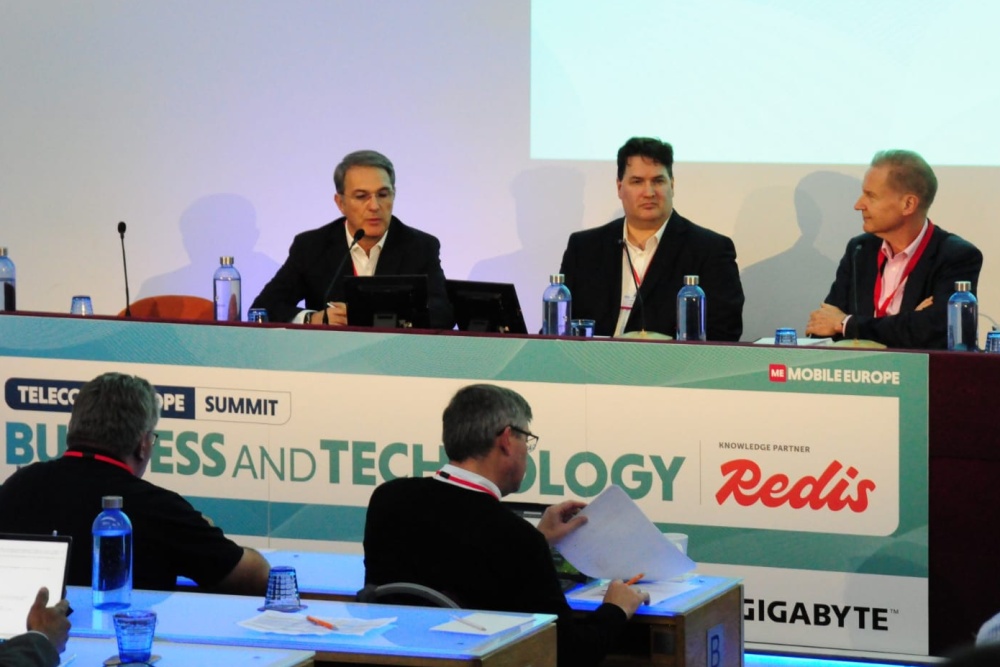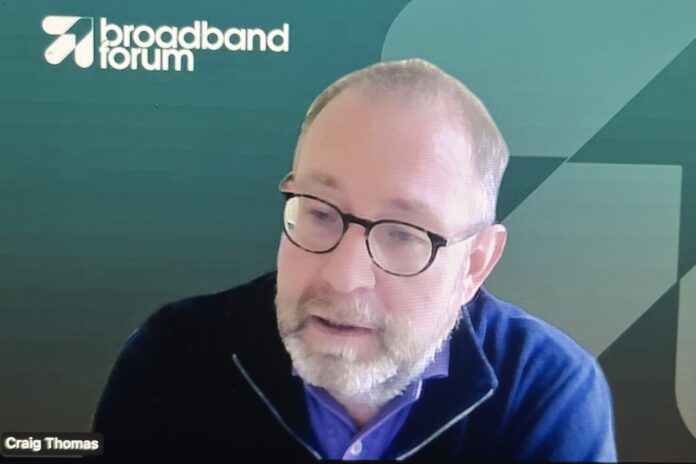Broadband Forum’s CEO explains why disaggregation changes the game, operationally and commercially, for broadband providers – whether as a deployment or migration strategy
The Broadband Forum extended its network disaggregation principles out to fixed broadband access nodes. We asked Craig Thomas, CEO of the Broadband Forum, to explain why this approach brings operational, financial, commercial and strategic benefits to providers of fixed broadband infrastructure – and those who provide services on top.
Thomas says, “Some of the catalysts for disaggregation across 5G, 6G and fixed fibre will be similar: software-defined networking (SDN) is pretty much driven from the 5G world into fixed. There’s overlap that’s going to accelerate the adoption of disaggregation.”
He adds, “From a fixed point of view…we started in the SDN core, and it’s been slowly moving out to the edge. There’s a lot work around how to disaggregate and virtualise functions like the broadband network gateway (BNG), which manages subscribers’ services…Now we’re moving even further out, to the access node. In the fibre world, that means to the optical line terminal (OLT). In a mixed world of copper, then it could be the multi-service access node or MSAN.”
Capex AND opex advantages
According to Thomas there is a two-fold need for this approach. The first is so that fibre providers don’t need to buy separate control plane management platforms for each access node or BNG. The second is being able to expand the network faster with fewer opex costs from downtime for network upgrades, etc. because the upgrade is just done once.
Thomas says, “We work closely with 3GPP In a separate piece of work we call wireless/wireline convergence – the question is how to maintain a single core network? The Forum is working on Access Gateway functionality so that operators can avoid running two SDN networks – one for fixed or one mobile – instead running a converged single core and SDN environment.
“There’s a lot in the thought process behind this – our standards work addresses needs identified and requested by service providers. Then some of those service providers and the vendor community get together and say, ‘How do we write this open standard to make it happen?’ There’s the data model, the architecture etc.”
In May, the Forum published enhancements to 5G convergence standards. These Phase 18.1 specifications build on 3GPP’s Release 18 to extend the set of common capabilities. The idea is that operators can customise the Quality of Service they offer to differentiate themselves. Also, they gain more flexibility to migrate to a single, converged 5G Core within a multi-vendor broadband network.
This helps both the wholesale provider of fibre infrastructure as well as those providing selling services over it because, as Thomas notes, wholesalers can only provide so many packages to ISPs. He says, “They can’t support 100 different flavours because it becomes too hard to manage. A number of years ago, we introduced standards around something called Band X access network sharing. If you look at the glory of what 5G brings to scalability – the network and network slicing – we can bring that to the fixed network as well, and network slice all the way down to the OLT.”
He continues, “I don’t just have to sell you a per-port, bitstream type service. I can sell a virtual network operator service where I will supply all the network access, down to the hand-off peering so you have visibility all the way to the OLT. I’m virtually lifting and sharing the OLT between [retail] operators, not just selling one port.
Separating the physical and control
“We’re separating the physical from the management and the control planes completely. If we can do that, why can’t we separate the control plane to multiple wholesale providers, not just one? The [thinking] originated from marketplaces where there was no point in overbuilding fibre. In the UK, BT, Virgin Media O2 and CityFibre might build a fibre network in the same serving area. Why not build one, deploy the OLT then share the virtualised OLT in an SDN environment?”
In other words, differentiation should be what happens on top of the ‘plumbing’ rather than competing infrastructure. Disaggregation offers many commercial as well as opex and capex opportunities.
“The most obvious one for capex is not needing a branded OLT with the control user plane and subscriber management built into every single access node,” Thomas says. “SDN, NFV and disaggregation gives operators the option of moving to a white box model – buying an OLT that’s an x86 server with some optical SFPs [small form-factor pluggable – compact network interface format] in it.”
He continues, “When you’re looking at things like the supply chain, disaggregation allows me to pick and choose anytime I want which access node or OLT [to use] in my network because the clever stuff is done in the cloud and by the SDN.”
Thriving in consolidation
This has big implications, given that in many markets the consolidation of alternative fibre network providers looks inevitable. Thomas explains, “If I can virtualise the functionality in the cloud, I don’t have to rip and replace if multiple operators consolidate their networks because the basic physical functionality of the access nodes and the OLT stay the same. I can have a single management and a single subscriber orchestration that manages all those devices, whatever they were, as long as the technology is standardised, whether that’s PON [passive optical network], point to point, or even copper. That’s a big benefit as well for future investment in fibre networks.”
He adds, “We also do something that is part of what we call an open broadband project, which is open-source software. We provide the migration strategy for those that offer traditional, monolithic type access so they can migrate them to an SDN when it makes sense. Again, it’s never replacing equipment.
So where is the intelligence in the network? “If you move to a disaggregated strategy, you can put the intelligence wherever you want in the network – consolidate it in a single cloud environment for instance, but you can also distribute intelligence to a metro edge compute type environment, say to give the flexibility of putting intelligence wherever you want it in the network,” according to Thomas.
Does one size suit all? He talks to US fibre broadband providers who are only serving 20,000 people: “I tell them they are investing now for 20,000 people, but whenever they go into a new city or town, or acquire [another provider], they’ve got that flexibility.”
Home hybrid gateways
Another avenue under development by the Broadband Forum is work the disaggregation of hybrid home gateways so that fibre networks providers “don’t need three models. I can have one home gateway model and one data model whether it’s a 5G home gateway, a fibre home gateway, or a hybrid one with backup services. Whatever the technology, it’s the same disaggregated network.
“So it doesn’t matter where they’re sitting, I recognise from my 5G world that it’s using the SIM card inside the home gateway, or automatically my OLT recognises that same home gateway has a fibre connection and needs to be directed to the access gateway functionality in the fixed or common core. That’s the flexibility of SDN, build it once instead of multiple times.”
Is there resistance in the market to this approach?“Not resistance. You’re always going to have the market leaders, the first adopters, with others questioning when it makes sense to move and often it’s the Tier 1s who are the first movers because they’re the ones with knowledge of SDNs, the software and data centres that they’re learning and taking to the core.”
Not all first movers are Tier 1s though, for example many new so-called altnets went straight to the latest technology because it does not made sense to deploy legacy. Regardless of size or age, Thomas stresses the importance of open source for open broadband standards and that it is imperative to provide a migration path to avoid rip and replace.
This, he says, allows operators to amortise their network investment over as long a period as suits their circumstances but have a clear path to SDN.
He concludes, “The great thing about this work is that it’s just as applicable to existing assets that [fibre providers] bought from a traditional vendor as the new network access they might deploy in future, whether using a grey or white box model, or one that’s vendor branded.”
Rethinking FTTP and multi-service fibre
Thomas says, “I’m lucky to chair an Executive Advisory Board where some of the largest service providers are telling me that the future of FTTP cannot just be seen as a residential network [for consumers]. They say we need to terminate multi-service fibre – build one network but have options for the business across there, the residential here plus for smart cities and mobile backhaul. Otherwise they are amortising and investing in that fibre more than once for different subscriber groups, or different types of user.”
This marks a sea change he says because “traditionally it’s been the new competitive providers that want to use FTTP for business while the Tier 1s’ attitude was, ‘I’ve built a business network, why would I want to reduce its value by saying you can have the same service on an FTTH network when I built this big, expensive, lambda optical network with dark fibre, MPLS and the like?’. But they can drive those technologies now onto the FTTH and even the Tier 1s are seeing this to justify network investment. It’s an interesting discussion.”
Here’s the pay off
Tier 1s should not see this as a bad thing, Thomas argues, but an opportunity to level disaggregation in fibre to the network access level. According to the European Union, 99% of businesses in Europe – about 24.3 million – are SMEs, defined as employing up to 250 persons with annual turnover not exceeding €50 million. Thomas says half of them buy residential, rather than business, broadband. In addition, there are many thousands of people who work from home at least some of the time.
He points out that if operators can promote a service level agreement for those working at home – guaranteeing a certain level of service for the business user, a different level for children who are streaming content and perhaps another for the gamers in the family. Each might need a service with different parameters where different levels of experience are acceptable. Each guaranteed service will only cost an operator €2 or €3 or dollars or pounds more, Thomas says.
“It’s not a big expense but the home user, the teleworker, the cafe owner or whoever can justify each element they need and they’re not suddenly looking at a jump from £25 pounds a month to £100. It’s incremental pick and choose. That’s what service level broadband means – it’s more than broadband connectivity,” and it can all be enabled by pushing disaggregation closer to the end user.
————————————————————————————————————–
You might also be interested in this panel discussion, Financing fibre and making a return on invested capital, with Carlos Bouca, Director of Network Engineering and Operations at Altice Portugal (left below), Clayton Nash, Strategy Director at CityFibre (pictured centre) and moderated by Chris Godsmark, MD, Houlihan Lokey’s Global Technology Group. From our recent Business & Technology event in central London




